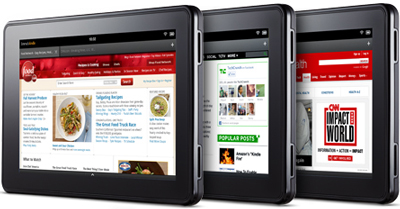News
$199 Kindle Fire Tablet Announced by Amazon
Amazon announced today in New York that its Kindle Fire tablet will ship Nov. 15 for $199.
Given the low price point and Amazon's huge consumer reach, the Kindle Fire appears to be the most promising effort yet to challenge the iPad, though analysts don't see it putting a huge dent in the market for Apple's popular slate.
"Apple's place as market leader is secure, but Amazon will be a strong number two, and we expect no other serious tablet competitors until Windows 8 tablets launch," said Forrester analyst Sarah Rottman Epps in a blog post. "Amazon will sell millions of tablets, and the rapid fire adoption of the Kindle Fire will give app developers a reason -- finally -- to develop Android tablet apps."
The Kindle Fire is one of four Kindle devices launched at the event, though the other three are designed as e-readers. With a 7-inch color display, the Kindle Fire is smaller than the 10-inch Apple iPad. But the Kindle Fire, which weighs 14.6 ounces, will appeal to those who want a device that can browse Web sites and access Amazon's vast catalog of content.
In addition to books, customers will be able to use the Kindle Fire to watch movies and television shows, as well as access Amazon's catalog of magazines, games, music and other apps, the company said.
"Kindle Fire brings together all of the things we've been working on at Amazon for over 15 years into a single, fully-integrated service for customers," said Amazon founder and CEO Jeff Bezos in a statement.
Amazon also launched a new Web browser, called Silk, which is loaded on the Kindle Fire. Silk uses what the company calls a "split-browser" architecture that leverages caching on the Kindle Fire and the company's Amazon Web Services Elastic Compute Cloud (EC2) cloud infrastructure.
The Silk browser resides in components both on Kindle Fire and EC2. When a user requests a page from the device, the browser dynamically splits the workload between the system and the EC2 cloud. Factors such as available bandwidth, the nature of the page and what is already cached come into play. Silk uses EC2 to process and access the components of a site, thereby providing a fast stream.
While typical Web browsers can't download Web content until it receives the HTML file, Amazon said Silk learns page characteristics by aggregating page loads with the intelligence residing on EC2, according to the company.
"We re-factored and rebuilt the browser software stack and now push pieces of the computation into the AWS cloud," Bezos said. "When you use Silk -- without thinking about it or doing anything explicit -- you're calling on the raw computational horsepower of Amazon EC2 to accelerate your Web browsing."
The company said it is offering customers cloud storage with the device.
 |
| Kindle Fire tablet with Silk browser. (Source: Amazon) |
About the Author
Jeffrey Schwartz is editor of Redmond magazine and also covers cloud computing for Virtualization Review's Cloud Report. In addition, he writes the Channeling the Cloud column for Redmond Channel Partner. Follow him on Twitter @JeffreySchwartz.